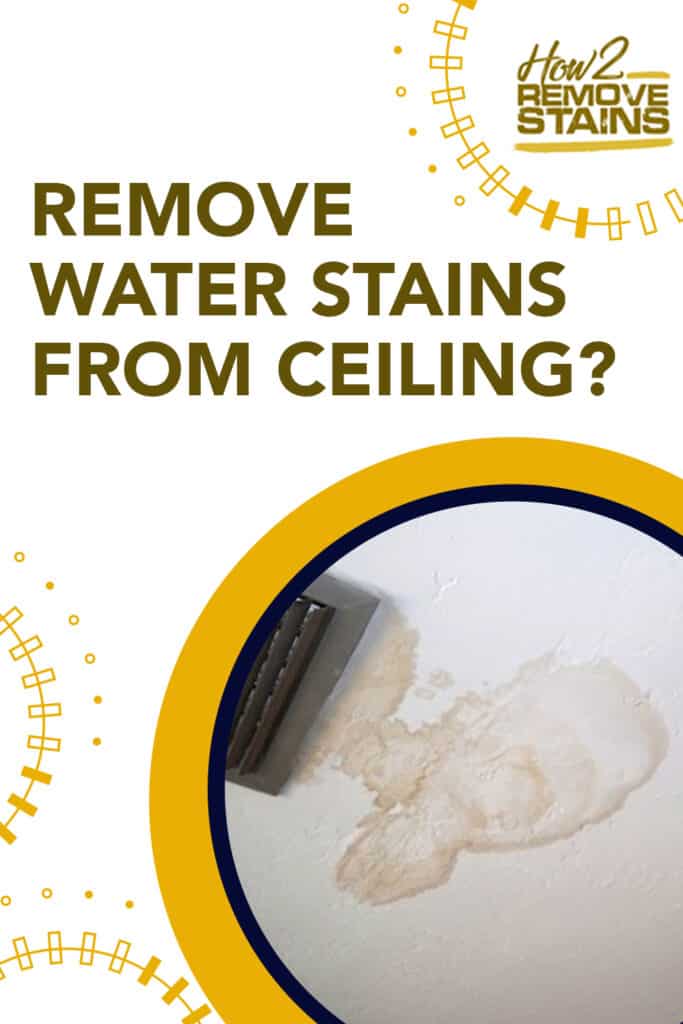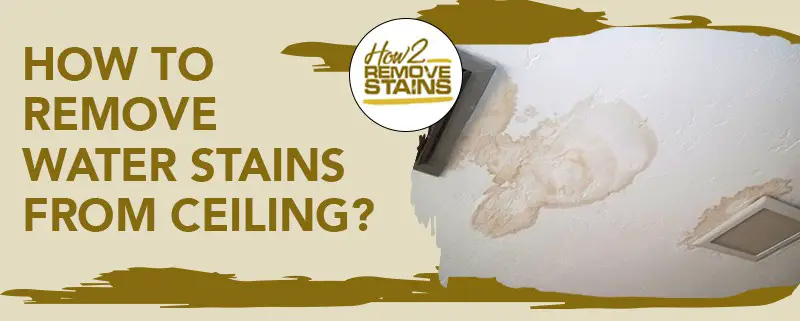Water stains on the ceiling are not complementary to a well-lit light fixture. This stain must be managed before your entire ceiling gets ruined. When dealing with light water stains, common household bleach can lighten the water stain. But with stubborn stains, you need to check for more serious damage
Most importantly, you will need to find the source of the stain and make sure there’s not a problem with pipes in the wall. Often the best solution is to remove the stained part of the ceiling and replace it with a new one. You might have to paint over it or sand the surface down, depending on the material.
Table of Contents
Free your ceiling from water stains with bleach
This method is perfect if water stains on the ceiling form brownish discolorations. This is mainly due to the deposition of minerals from water after evaporation. The use of common household bleach (sodium hypochlorite) helps remove the brownish water stains.
This is possible because of the natural bleaching effect. In no time, the water stain will be removed through the combined action of the bleach and the agitation by rubbing. This method is also a go-to technique for old water stains on the ceiling.
When doing this method, always wear protective goggles to ensure your eyes are not exposed to even a single drop of the bleach solution. Also, wear gloves to avoid skin irritation and a face mask to avoid breathing in the harsh fumes.
- Fill a spray bottle with one-part bleach and three parts lukewarm water to make a solution. Gently mix the solution by flipping the bottle upside down a few times.
- Prepare another spray bottle and fill it with water alone.
- Position a ladder just below to reach the water stains on the ceiling.
- Generously spray the bleach solution all over the water-stained part of the ceiling.
- Grab a sponge or any non-abrasive brush, then rub the area in a circular motion.
- Continue repeating steps four and five until the water stains finally disappear.
- Spray water on the area to rinse it thoroughly.
- Blot dry using a clean, dry cloth.
Fix your ceiling to get rid of water stains
When water seeps into your ceiling and eventually evaporates, it can leave water stains behind. Sometimes the water doesn’t only stain your ceiling but damages it from the inside as well. If you’re dealing with more than just a stained surface, you can remove a part of your ceiling and replace it. This will get rid of the water stains and fix the damage at the same time. There are many ways to fix this staining problem on your ceiling.
Drywall ceiling
In fixing your water-stained drywall ceiling, you can use the bleach method coupled with primer and paint to fix your ceiling. The use of primer and paint will help you conceal the remaining water stains that were not removed by the bleach solution.
- Lessen the water stain discoloration using the bleach method mentioned previously. Allow the ceiling to dry.
- Cover light water stains on your ceiling with any primer and paint that will blend with your ceiling’s existing color.
Wood ceiling
Some old houses are made of wood ceilings. As beautiful as a wood ceiling is to look at, it will surely give you a hard time when removing water stains on its surface. This is because cutting the stained area and replacing it with an unstained wood is not practical, unlike other types of ceilings. When fixing a water-stained wood ceiling, you must follow this procedure.
- Identify the area where water is not yet seeped into the wood.
- Using medium and fine-grain sandpaper, sand the identified area making sure that you are evenly dislodging the superficial water-stained layer of the wood.
- Afterward, apply a sealer on the wood.
Common questions about water stains
What is the first thing to do when water stains appear on the ceiling?
In treating water-stained ceilings, the first step will always be fact-finding. This is anchored on locating the leakage’s exact source that has caused water stains to occur on your ceiling. Once you find it, resolve the leakage problem first with the help of a plumber if necessary. Only then can you proceed with the removal of the water stains from your ceiling.
How can I remove water stains from a wood ceiling without using sandpaper?
You have two options to choose from when removing water stains from a wood ceiling. If it’s a dark wood ceiling, you can re-stain the spot where the wood color has slightly faded. Use any stain that forms dark discoloration to match the dark-colored wood. If you have a lighter wood ceiling, use oxalic wood bleach to bleach the water stain that caused discoloration on the wood.
Can I use dish soap to remove water stains on the ceiling?
The use of mild dish soap is only applicable for light water stains. The dish soap method can only be used if the ceiling can be treated with liquid. Active components of dish soap are designed to loosen the mineral deposits and eventually remove water stains. This is a normal cleaning process that does not guarantee full removal of the stain.
- Prepare a solution of one cup of warm water with five drops of mild dish soap.
- Soak a sponge in the solution. Wring it and use it to scrub the water-stained ceiling.
Does water stain ceiling mean mold?
Water stains on the ceiling do not always come with the growth of mold. However, due to constant contact with water, the ceiling will eventually be the ideal place for mold growth. To prevent this from happening, make sure that you resolve leakage problems. Humidity can also affect the formation of mold, but it rarely occurs.
Final thoughts
Unsightly water stains on the ceiling need attention. The hardship of dealing with them comes with the type of material used in your ceiling. Removing this kind of stain is not the only thing you should. Always make it a point to find the root cause of these water stains so you can avoid encountering the same problem in the future.


